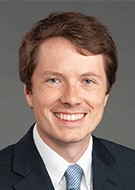RSNA Member Spotlight: Paul M. Bunch, MD
Learn more about a fellow RSNA member

Paul M. Bunch, MD, is an associate professor of radiology at the Wake Forest University School of Medicine in Winston-Salem, NC. Dr. Bunch earned his medical degree from the University of Virginia (UVA) School of Medicine in Charlottesville and is currently pursuing a Master of Science in Translational and Health System Science from Wake Forest University. He completed his radiology residency at Brigham and Women's Hospital and a neuroradiology fellowship at Massachusetts General Hospital, both in Boston.
Dr. Bunch’s primary clinical and research interests relate to head and neck imaging, including primary hyperparathyroidism, head and neck cancer, and head and neck anatomy. He serves on the editorial board of RadioGraphics and on the Head and Neck Subcommittee of the RSNA Annual Meeting Program Planning Committee. In addition to volunteering with RSNA, Dr. Bunch actively serves the American College of Radiology, the American Society of Neuroradiology and the American Society of Head and Neck Radiology.
What or who sparked your interest in radiology?
As a medical student, I realized that what I enjoy most about medicine is analyzing and interpreting sets of data and generating differential diagnoses based on these interpretations, and that I derive the most pleasure from the analysis and interpretation of images and the critical thinking about diagnostic possibilities that such interpretation stimulates. I was fortunate to connect with Dr. Cree Gaskin for a summer research project, which led to some RSNA presentations, a bone age atlas published by Oxford University Press, and a longitudinal mentoring relationship that continues to this day.
My interest in head and neck imaging stems from a two-week rotation at Massachusetts Eye and Ear during my third year of residency. I had enjoyed everything in radiology up to that point and was unsure as to my fellowship choice. It only took a few days learning from Dr. Hugh Curtin and the many other amazing head and neck radiologists there for me to realize that I want to do what these folks do, and I hope to someday do it as well as they can.
What has been the best professional accomplishment in your career?
So far, it’s receiving the AUR Care and Equity in Radiology Research Academic Fellowship, formerly the GE Radiology Research Academic Fellowship Award. I’m grateful to my mentors, Drs. Leon Lenchik, Jonathan Burdette and Chris Whitlow, for supporting me and encouraging me to go for something that I personally considered to be beyond my reach. This program has connected me with an amazing mentorship network, allowed me to pursue a horizon-broadening master’s degree in translational and health system science and supported our multidisciplinary team’s research related to primary hyperparathyroidism.
Primary hyperparathyroidism is more common than many people realize and contributes to substantial patient morbidity and health system costs. Our team is not only working to further refine established approaches to preoperative imaging localization for patients with known disease, but we are also investigating the potential for leveraging findings from imaging studies performed for other reasons to identify individuals at increased risk of undiagnosed parathyroid disease who would benefit from additional evaluation.

What has been the biggest challenge you have faced in building your career?
Two challenges that I think many can identify with are first, navigating the transition from trainee to attending and second, attempting to strike an appropriate balance between pursuing the research and educational projects about which I am passionate and being a good husband and father.
With regard to the first, I benefitted tremendously from outstanding residency and fellowship training and from a very supportive environment in my first faculty position at Wake Forest. It was also helpful to discuss strategies for successfully navigating this transition with others who did it before me and, in my judgment, had done it well.
Facing the second challenge remains a work in progress. I’m fortunate to have a wonderful family and ample opportunities to contribute to professional projects that I think are important. When I was getting started, I said “yes” to pretty much every professional opportunity offered. Now that I am a little more established, when presented with a new opportunity, I’m more comfortable acknowledging the fact that, although I would love to participate, I often simply don’t have the available bandwidth I know is needed to do the job well. Fortunately, these situations are often opportunities to “pay forward” to mentees some of the past opportunities I have received from mentors and sponsors.
What RSNA resources do you use/have you used to assist you with your professional development and in your daily practice?
As a resident, I attended the RSNA/AUR/ARRS Introduction to Academic Radiology (ITAR) program and found it to be incredibly helpful. I would encourage any trainees who have the opportunity to participate in this program to take advantage. I also find the RSNA annual meeting content and social events to be a great resource, both in terms of daily practice and professional development. RadioGraphics is a go-to resource in the reading room, both for teaching trainees and for improving my own knowledge base.
When you’re not working, how do you like to spend your free time?
I enjoy going for walks, binge-watching TV shows with my wife, fishing with my kids and seeing live music. Give a listen to Billy Strings and to Goose if you’re not listening to them already!
For More Information
Follow Dr. Bunch on X @pbunchmd.
Keep up to date on RSNA member achievements, moves and news by visiting RSNA.org/Announcements/Member-Updates.